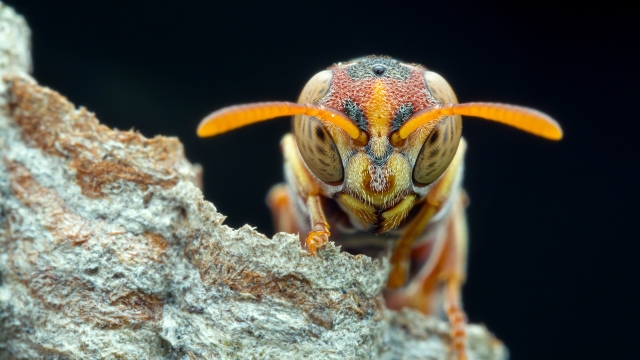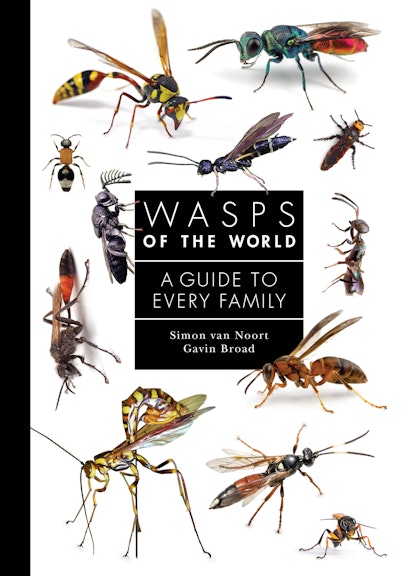Wasps are super successful organisms having proliferated over 280 million years to become, arguably, the largest order of insects—the Hymenoptera (wasps, bees and ants). They comprise about 150,000 known species, but there are probably at least ten-times this number of unknown species. Wasps eat our pest insects, they pollinate our crops, they maintain the planet’s terrestrial food-webs. Wasps deploy powerful venoms and hormones which paralyse hosts and prey, manipulate the behaviour of their hosts, and sometimes cause us pain. They have a reproductive system in which males hatch from unfertilised eggs, so wasps can choose their sex ratios. They vary in size from 0.13 mm to 11 cm. They have evolved a dazzling variety of colour patterns and body forms, driven fundamentally by their strategy of exploiting other insects as food.
As well as the legions of parasitoids and predators, ants and bees are also specialist groups of wasps which have played outsized roles in ecosystem services, particularly pollination and recycling of nutrients. On the other hand, wood-wasps and sawflies can cause huge losses of timber, and invasive paper wasps and yellowjackets wreak havoc around the world. In short, the Hymenoptera plays a massive role in sculpting our world. Their continued conservation and presence are essential for our own well-being but, rather scarily, we know very little about the world’s incredibly rich species diversity, and even less about their ecological interactions.
Parasitoid wasps are the most diverse group within the Hymenoptera and are supreme insect population controllers. Various species attack every developmental stage of the host insect from eggs to adults. Almost all species of insect and many arachnids are attacked by parasitoid wasps and in most cases by more than one species. While some parasitoids attack many host species, the majority are specialised to some degree. Consequently, the Hymenoptera must be, by far, the most diverse order of insects—on average 2-3 species of parasitoid wasps are associated with every insect species in the world.
Without parasitoids, massive population explosions of insects would decimate our environment, including our agricultural and forestry industries. As such these wasps are essential contributors to food security and to maintaining our environmental life support systems in a healthy state. Parasitoid food webs, however, can be extremely complex containing numerous feeding levels, often comprising the primary parasitoid of the host as well as several levels of secondary species attacking the parasitoid wasps that are attacking other parasitoid wasps, all of which are developing on the same host insect!
The smallest insects in the world are parasitoid wasps in the family Mymaridae (commonly called Fairyfly wasps because of their feathery wings). At 0.15mm females of the fairyfly wasp Kikiki huna represent the smallest winged insect species, but wingless males of another fairyfly wasp Dicopomorpha echmepterygis are even smaller at 0.13mm. The size of these minute, fully developed adult wasps is dictated by the limited food resources available for their larvae that develop inside tiny host insect eggs, eventually killing the host.
Wasps are proficient architects, the paper wasps fashioning complex social nests with hexagonal cells out of chewed up wood fibres they have collected, mixed with saliva to produce a paper-mâché like product, observation of which purportedly led to the first production of paper in China eons ago; the mud daubers or potter wasps constructing mud nests of various shapes, diligently built one mud pellet at a time, repeatedly scavenged from nearby muddy water sources, and carried in flight using their mandibles. Some are spinners, like caterpillars many wasp larvae are silk spinners, fashioning their cocoons in intricate manner.
Wasps are often feared and revered as nasty, primarily due to the stinging ability of a few of the more charismatic species. Wasp venom ranges tremendously in potency with social species having evolved painful stings to ward off potential vertebrate predators attacking their communal nest resources. Some solitary wasps such as the tarantula hawks (Pepsis hero at 11 cm long being the largest species) have a powerful venom used to subdue their large spider prey, the pain registering as the second most potent on the Schmidt pain index, with only the South American bullet ant (Paraponera clavate) superseding this. The injected venom paralyses the spider prey, keeping it alive and fresh for the wasp larva that will feast on the body contents for its own development. Not all is venom woe though—we may benefit through the discovery that the venom of the Brazilian paper wasp Polybia paulista, contains a toxin (Polybia-MP1) that targets and kills cancer cells without harming the surrounding healthy tissue.
Wasps are useful! As part of biocontrol programs, we deliberately and effectively use parasitoid wasps to control pest species of insects attacking our agroecosystems, or to control alien invasive insects and plants. Using parasitoids to control pests of crops reduces the need for insecticide use and mitigates the resultant knock-on effect on health of the broader environment. Invasive species have a major negative impact on our indigenous ecosystems, many of which are kept under control by parasitoid wasps. Exotic invasive waterweeds are a major issue clogging our water systems and impacting on their efficient functioning, and are often controlled by introduced plant feeding insects, but parasitoid wasps also attack biocontrol agents, and hence may have a negative impact in these cases.
The higher aculeate wasps hunt a variety of insect prey from small aphids and flies to large grasshoppers, cicadas and caterpillars, which they may chew up in the case of the social species, before feeding to their young, but more commonly the female wasp provisions a nest site with the prey on which she lays an egg. The hatching wasp larva then has a bountiful and secure food resource to develop on.
Although most feeding occurs in the larval stage, adult wasps also need to imbibe nutrients, which in the case of the parasitoids they obtain from body fluids exuding from puncture wounds on the host insect during the process of egg laying, but they also feed on nectar for their energy requirements, and in the process perform critical pollination services. Some of these pollinator/plant interactions are highly specialised. The most well-known is the classic example of an obligate mutualism that exists between fig wasps and their host fig trees, neither of which can survive without the other. Fig trees are completely reliant on tiny fig wasps for pollination, and in turn the wasps can breed nowhere else except inside figs. Fig trees are keystone species in tropical ecosystems with many other animals relying on the food resources provided by Ficus species for their own survival. Some plants such as the orchid Chiloglottis trapeziformis practice sexual deception. The flower produces a volatile compound mimicking the female wasp’s sex pheromone that attract males of the thynnine wasp Neozeleboria cryptoides. The males are fooled into pollinating the flower while in the act of deceitful mating rapture.
Loss of parasitoid and pollinating wasps would have catastrophic cascading effects on the ecosystems we rely on for our own wellbeing. With rapidly increasing environmental destruction, we desperately need to raise awareness of the importance of wasps and for that matter insects in general. We are losing species to extinction faster than we can discover and describe them and are in the midst of an insect apocalypse. It is a race against time to escalate the discovery and documentation of the wealth of unknown species, to implement effective conservation measures before it is too late. Wasps probably require the most work since they comprise the vast majority of unknown insect species—an extremely sobering realisation given that we rely on them for so many beneficial services!
Simon van Noort is curator of entomology at the Iziko South African Museum in Cape Town and coordinator of WaspWeb.org, a bioinformatics resource for wasps of the Afrotropical region.
Gavin Broad is principal curator in charge of insects at the Natural History Museum in London and associate editor of the European Journal of Taxonomy and Insect Conservation and Diversity.

